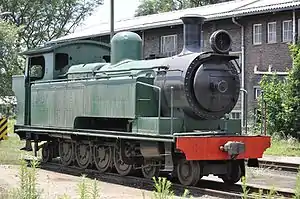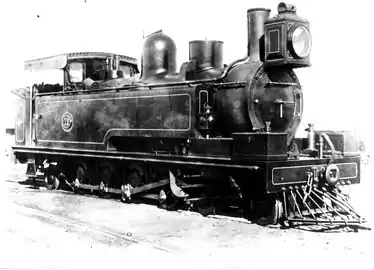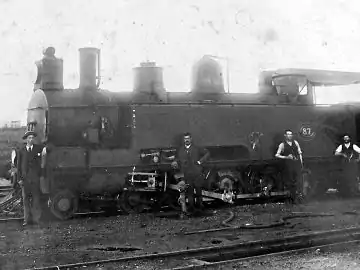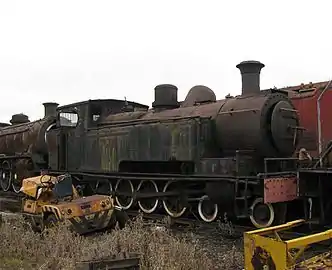South African Class A 4-8-2T
The South African Railways Class A 4-8-2T of 1888 was a steam locomotive from the pre-Union era in the Colony of Natal.
| NGR Class D1 & D2 4-8-2T South African Class A 4-8-2T | |||||||||||||||||||||||||||||||||||||||||||||||||||||||||||||||||||||||||||||||||||||||||||
|---|---|---|---|---|---|---|---|---|---|---|---|---|---|---|---|---|---|---|---|---|---|---|---|---|---|---|---|---|---|---|---|---|---|---|---|---|---|---|---|---|---|---|---|---|---|---|---|---|---|---|---|---|---|---|---|---|---|---|---|---|---|---|---|---|---|---|---|---|---|---|---|---|---|---|---|---|---|---|---|---|---|---|---|---|---|---|---|---|---|---|---|
 SAR Class A Belpaire no. 196, ex NGR no 133, at Masons Mill, Pietermaritzburg, 10 December 2010 | |||||||||||||||||||||||||||||||||||||||||||||||||||||||||||||||||||||||||||||||||||||||||||
| |||||||||||||||||||||||||||||||||||||||||||||||||||||||||||||||||||||||||||||||||||||||||||
| |||||||||||||||||||||||||||||||||||||||||||||||||||||||||||||||||||||||||||||||||||||||||||
| |||||||||||||||||||||||||||||||||||||||||||||||||||||||||||||||||||||||||||||||||||||||||||
| |||||||||||||||||||||||||||||||||||||||||||||||||||||||||||||||||||||||||||||||||||||||||||
| The leading coupled axle had flangeless wheels | |||||||||||||||||||||||||||||||||||||||||||||||||||||||||||||||||||||||||||||||||||||||||||
In 1888, the Natal Government Railways placed the first five of its eventual one hundred Class D 4-8-2T steam locomotives in service. The last was delivered in 1899. They were the first locomotives in the world to be built with a 4-8-2 wheel arrangement, later to become known as the Mountain type. In 1912, when these locomotives were assimilated into the South African Railways, they were renumbered and designated Class A. In 1915, another two Class A locomotives were built from spare parts.[1][2]
Manufacturers
The Natal Government Railways (NGR) Class D 4-8-2 tank locomotive was designed by William Milne, the Locomotive Superintendent of the NGR from 1877 to 1896, and was built by Dübs and Company. The first 46 locomotives, with an operating boiler pressure of 140 pounds per square inch (965 kilopascals) and numbered in the range from 49 to 94, were placed in service during Milne's term. They proved to be such good engines that, when G.W. Reid took over as Locomotive Superintendent in 1896, he continued to place further orders for another 58, numbered in the range from 91 to 148, but with the boiler pressure increased to 160 pounds per square inch (1,103 kilopascals). These 100 locomotives, initially known on the NGR as the Dübs A, were delivered in ten batches by Dübs between 1888 and 1899.[1][3][4]
As far as is known, the Dübs A locomotives were the first in the world to be designed and built with a 4-8-2 wheel arrangement, later to become known as the Mountain type.[1]
Modifications
The performance in service of the Dübs A was gradually improved by various modifications. New boilers were fitted as and when the originals needed replacement, with a working pressure of 160 pounds per square inch (1,103 kilopascals) instead of the as-delivered 140 pounds per square inch (965 kilopascals) of the first few batches. This increased their tractive effort at 75% boiler pressure from 16,340 pounds-force (72.7 kilonewtons) to 18,670 pounds-force (83.0 kilonewtons). The coal bunkers were also enlarged and the connecting rod big-ends were changed to the marine type to increase ground clearance.[1][3]
Another modification was an extended smokebox on most locomotives, such as on NGR no. 87 depicted below. In the 1890s, some improvements to smokebox design took place. Extending the smokebox forward increased its volume. The increased amount of exhaust gases present in the smokebox had the effect of stabilising and improving the draught. The date of this improvement can be pinned to 1891 when the second batch of Michael Stephens’ Cape Government Railways (CGR) 5th Class 4-6-0 locomotives with their lengthened smokeboxes entered service. This had such a profound effect on the boiler’s steaming ability that virtually every locomotive on the CGR and NGR had their smokeboxes extended.[5]
Beginning in 1905, after D.A. Hendrie took over from Reid as Locomotive Superintendent, these locomotives were gradually fitted with Belpaire fireboxes with wider firegrates. The flat-topped Belpaire firebox had the advantage of an increased area of the water-line at the hottest part of the boiler, together with increased steam space over the firebox. In order to accomplish this, Hendrie raised the boiler's pitch by 4 1⁄2 inches (114 millimetres) and cut away the frame under the firebox to accommodate the wider grates. The wider firebox required that the water tanks also had to be moved out and the opportunity was taken to enlarge the tanks. The cabs were also improved to offer the engine crew better protection, and new brass-capped chimneys replaced the original straight flared chimneys. These modified locomotives were known as the Improved Dübs A.[1][3]
When a locomotive classification system was introduced on the NGR, the Dübs A locomotive family was designated Class D. The unmodified locomotives became the Class D1 while the modified locomotives with Belpaire fireboxes became the Class D2.[1][6][7]
South African Railways
When the Union of South Africa was established on 31 May 1910, the three Colonial government railways (CGR, NGR and Central South African Railways) were united under a single administration to control and administer the railways, ports and harbours of the Union. Although the South African Railways and Harbours came into existence in 1910, the actual classification and renumbering of all the rolling stock of the three constituent railways was only implemented with effect from 1 January 1912.[8][9]
In 1912, these engines were designated Class A and were renumbered in the range from 97 to 196, with the unmodified Class D1 locomotives receiving the numbers in the range from 97 to 186 and the ten, at the time, already reboilered Class D2 locomotives receiving the numbers in the range from 187 to 196. In South African Railways (SAR) service, the Improved Dübs A locomotives became known as the Class A Belpaire.[8][10]
In 1915, to help counter wartime motive power shortages brought about by the diminished ability to order new locomotives from European builders due to hostilities, another two Class A locomotives were built from spare parts by the SAR in their Durban shops. These two locomotives were numbered 332 and 333.[10]
Service
In the NGR era, the Class D fleet remained in service on the Natal mainline until they were eventually displaced by more modern locomotives. They continued to serve well into the SAR era on the Dundee-Hlobane branchline, the Harrismith-Ladysmith section and on the north coast line to Empangeni.[10]
In 1915, shortly after the outbreak of the First World War, the German South West Africa colony was occupied by the Union Defence Forces. Since a large part of the territory's railway infrastructure and rolling stock was destroyed or damaged by retreating German forces, an urgent need arose for locomotives for use on the Cape gauge lines in that territory. In 1917, numbers 98 and 183 were transferred to the Defence Department for service in South West Africa. Both locomotives are believed to have returned to South Africa after the war.[11]
The last of the Class A was withdrawn from service in 1962. Several locomotives continued to serve in industrial use for many years.[10]
Preservation
A few survive in preservation.[1][10]
- Ex NGR no. 84, SAR no. 130 named Patrys, is plinthed at the Reefsteamers Depot in Germiston.[12]
- Ex NGR no. 90, SAR no. 136 named Umbilo, is in the care of the Umgeni Steam Railway.[13]
- Ex NGR no. 55, SAR no. 103, was moved from Witbank to the Outeniqua Transport Museum in George in August 2014.
- Ex NGR no 133, SAR Class A Belpaire no. 196, was plinthed at Masons Mill in Pietermaritzburg until it was repatriated to the United Kingdom in 2011. It is now displayed at the entrance to the Mizens Railway near Woking.[5][14]
- Ex NGR no. ?, SAR no. 176, on display at Brikor Limited, Olifantsfontein.
Rebuilding to Class 17 4-8-0TT
.jpg.webp)
When a shortage of suitable shunting locomotives developed in 1926, the SAR modified 21 Class A and Class A Belpaire 4-8-2T locomotives by removing the trailing bissel bogie and coal bunker, shortening the main frame and adding a tender to increase their coal and water capacity. Tenders from various scrapped locomotive types were used.[2][3][10]
These 21 rebuilt locomotives became the SAR Class 17 4-8-0 tank-and-tender locomotives, numbered in the range from 1415 to 1435. They were used as shunting locomotives around Durban and Port Elizabeth, until they were withdrawn from service by 1961.[3][10]
Works numbers
The builder's works numbers, years built, NGR and SAR numbers, firebox type and Class 17 numbers are listed in the table.
Builder |
Works No. |
Year |
NGR No. |
SAR No. |
Model |
Class 17 No. |
|---|---|---|---|---|---|---|
| Dübs | 2446 | 1888 | 49 | 97 | Dübs A | |
| Dübs | 2447 | 1888 | 50 | 98 | Dübs A | |
| Dübs | 2448 | 1888 | 51 | 99 | Dübs A | |
| Dübs | 2449 | 1888 | 52 | 100 | Dübs A | |
| Dübs | 2450 | 1888 | 53 | 101 | Dübs A | |
| Dübs | 2451 | 1888 | 54 | 102 | Dübs A | |
| Dübs | 2499 | 1889 | 55 | 103 | Dübs A | |
| Dübs | 2500 | 1889 | 56 | 104 | Dübs A | |
| Dübs | 2501 | 1889 | 57 | 105 | Dübs A | |
| Dübs | 2502 | 1889 | 58 | 106 | Dübs A | |
| Dübs | 2503 | 1889 | 59 | 107 | Dübs A | |
| Dübs | 2504 | 1889 | 60 | 108 | Dübs A | |
| Dübs | 2604 | 1890 | 61 | 109 | Dübs A | 1421 |
| Dübs | 2605 | 1890 | 62 | 110 | Dübs A | |
| Dübs | 2606 | 1890 | 63 | 111 | Dübs A | |
| Dübs | 2607 | 1890 | 64 | 112 | Dübs A | |
| Dübs | 2608 | 1890 | 65 | 113 | Dübs A | |
| Dübs | 2609 | 1890 | 66 | 114 | Dübs A | |
| Dübs | 2610 | 1890 | 67 | 115 | Dübs A | |
| Dübs | 2611 | 1890 | 68 | 116 | Dübs A | 1417 |
| Dübs | 2612 | 1890 | 69 | 117 | Dübs A | 1427 |
| Dübs | 2613 | 1890 | 70 | 118 | Dübs A | 1428 |
| Dübs | 2614 | 1890 | 71 | 119 | Dübs A | 1425 |
| Dübs | 2615 | 1890 | 72 | 192 | Belpaire | |
| Dübs | 2616 | 1890 | 73 | 120 | Dübs A | |
| Dübs | 2617 | 1890 | 74 | 121 | Dübs A | |
| Dübs | 2618 | 1890 | 75 | 122 | Dübs A | 1420 |
| Dübs | 2619 | 1890 | 76 | 123 | Dübs A | |
| Dübs | 2620 | 1890 | 77 | 124 | Dübs A | |
| Dübs | 2621 | 1890 | 78 | 125 | Dübs A | |
| Dübs | 2622 | 1890 | 79 | 126 | Dübs A | |
| Dübs | 2623 | 1890 | 80 | 193 | Belpaire | 1423 |
| Dübs | 2624 | 1890 | 81 | 127 | Dübs A | |
| Dübs | 2625 | 1890 | 82 | 128 | Dübs A | 1419 |
| Dübs | 2626 | 1890 | 83 | 129 | Dübs A | 1433 |
| Dübs | 2627 | 1890 | 84 | 130 | Dübs A | |
| Dübs | 2628 | 1890 | 85 | 131 | Dübs A | |
| Dübs | 2965 | 1892 | 86 | 132 | Dübs A | |
| Dübs | 2966 | 1892 | 87 | 133 | Dübs A | |
| Dübs | 2967 | 1892 | 88 | 134 | Dübs A | |
| Dübs | 3317 | 1895 | 89 | 135 | Dübs A | 1422 |
| Dübs | 3318 | 1895 | 90 | 136 | Dübs A | 1426 |
| Dübs | 3319 | 1895 | 91 | 137 | Dübs A | |
| Dübs | 3320 | 1895 | 92 | 138 | Dübs A | |
| Dübs | 3321 | 1895 | 93 | 139 | Dübs A | |
| Dübs | 3322 | 1895 | 94 | 140 | Dübs A | |
| Dübs | 3363 | 1896 | 95 | 141 | Dübs A | |
| Dübs | 3364 | 1896 | 96 | 142 | Dübs A | |
| Dübs | 3365 | 1896 | 97 | 143 | Dübs A | |
| Dübs | 3366 | 1896 | 98 | 144 | Dübs A | |
| Dübs | 3367 | 1896 | 99 | 145 | Dübs A | |
| Dübs | 3368 | 1896 | 100 | 146 | Dübs A | |
| Dübs | 3477 | 1897 | 101 | 147 | Dübs A | 1434 |
| Dübs | 3478 | 1897 | 102 | 148 | Dübs A | |
| Dübs | 3479 | 1897 | 103 | 149 | Dübs A | |
| Dübs | 3480 | 1897 | 104 | 150 | Dübs A | |
| Dübs | 3481 | 1897 | 105 | 151 | Dübs A | 1431 |
| Dübs | 3482 | 1897 | 106 | 152 | Dübs A | |
| Dübs | 3483 | 1897 | 107 | 153 | Dübs A | |
| Dübs | 3484 | 1897 | 108 | 154 | Dübs A | 1416 |
| Dübs | 3485 | 1897 | 109 | 194 | Belpaire | |
| Dübs | 3486 | 1897 | 110 | 155 | Dübs A | |
| Dübs | 3604 | 1898 | 111 | 156 | Dübs A | |
| Dübs | 3605 | 1898 | 112 | 157 | Dübs A | 1432 |
| Dübs | 3556 | 1898 | 113 | 158 | Dübs A | 1415 |
| Dübs | 3557 | 1898 | 114 | 187 | Belpaire | |
| Dübs | 3558 | 1898 | 115 | 159 | Dübs A | |
| Dübs | 3559 | 1898 | 116 | 160 | Dübs A | |
| Dübs | 3560 | 1898 | 117 | 161 | Dübs A | |
| Dübs | 3561 | 1898 | 118 | 165 | Dübs A | |
| Dübs | 3562 | 1898 | 119 | 162 | Dübs A | |
| Dübs | 3563 | 1898 | 120 | 166 | Dübs A | 1424 |
| Dübs | 3564 | 1898 | 121 | 163 | Dübs A | 1435 |
| Dübs | 3565 | 1898 | 122 | 164 | Dübs A | |
| Dübs | 3566 | 1898 | 123 | 188 | Belpaire | |
| Dübs | 3567 | 1898 | 124 | 195 | Belpaire | |
| Dübs | 3811 | 1899 | 125 | 167 | Dübs A | |
| Dübs | 3812 | 1899 | 126 | 168 | Dübs A | |
| Dübs | 3813 | 1899 | 127 | 169 | Dübs A | |
| Dübs | 3814 | 1899 | 128 | 170 | Dübs A | |
| Dübs | 3815 | 1899 | 129 | 171 | Dübs A | |
| Dübs | 3816 | 1899 | 130 | 172 | Dübs A | |
| Dübs | 3817 | 1899 | 131 | 173 | Dübs A | |
| Dübs | 3818 | 1899 | 132 | 189 | Belpaire | |
| Dübs | 3819 | 1899 | 133 | 196 | Belpaire | |
| Dübs | 3820 | 1899 | 134 | 190 | Belpaire | 1418 |
| Dübs | 3821 | 1899 | 135 | 174 | Dübs A | |
| Dübs | 3822 | 1899 | 136 | 175 | Dübs A | |
| Dübs | 3823 | 1899 | 137 | 176 | Dübs A | |
| Dübs | 3824 | 1899 | 138 | 177 | Dübs A | |
| Dübs | 3825 | 1899 | 139 | 178 | Dübs A | |
| Dübs | 3826 | 1899 | 140 | 179 | Dübs A | |
| Dübs | 3827 | 1899 | 141 | 191 | Belpaire | 1430 |
| Dübs | 3828 | 1899 | 142 | 180 | Dübs A | |
| Dübs | 3829 | 1899 | 143 | 181 | Dübs A | 1429 |
| Dübs | 3830 | 1899 | 144 | 182 | Dübs A | |
| Dübs | 3831 | 1899 | 145 | 183 | Dübs A | |
| Dübs | 3832 | 1899 | 146 | 184 | Dübs A | |
| Dübs | 3833 | 1899 | 147 | 185 | Dübs A | |
| Dübs | 3834 | 1899 | 148 | 186 | Dübs A | |
| SAR | 1915 | 332 | Belpaire | |||
| SAR | 1915 | 333 | Belpaire | |||
Illustration
The main picture shows SAR Class A Belpaire no. 196 at Masons Mill on 10 December 2010. Those following illustrate the short and long smokebox versions of the locomotive and some of the post-delivery changes which were made, such as the altered cab for better crew protection.
 NGR Class D1 no. 72 with short smokebox, c. 1900
NGR Class D1 no. 72 with short smokebox, c. 1900 NGR Class D1 no. 87 with extended smokebox, c. 1898
NGR Class D1 no. 87 with extended smokebox, c. 1898.jpg.webp) NGR Class D1 no. 105 with short smokebox, c. 1900
NGR Class D1 no. 105 with short smokebox, c. 1900 SAR Class A no. 103 with Belpaire firebox, 2010
SAR Class A no. 103 with Belpaire firebox, 2010
References
| Wikimedia Commons has media related to South African Class A 4-8-2T. |
- Holland, D.F. (1971). Steam Locomotives of the South African Railways. 1: 1859–1910 (1st ed.). Newton Abbott, Devon: David & Charles. pp. 90–93. ISBN 978-0-7153-5382-0.
- South African Railways and Harbours Locomotive Diagram Book, 2'0" & 3'6" Gauge Steam Locomotives, 15 August 1941, as amended
- Espitalier, T.J.; Day, W.A.J. (1944). The Locomotive in South Africa - A Brief History of Railway Development. Chapter III - Natal Government Railways. (Continued). South African Railways and Harbours Magazine, June 1944. pp. 422-423.
- Pattison, R.G. (1997). The Cape Seventh Class Locomotives (1st ed.). Kenilworth, Cape Town: The Railway History Group. p. 6. ISBN 0958400946.
- Comment no 52287 in the SAR-L Yahoo Group: Comment from Leith Paxton: Summary of all comments on 22 February 2017
- Durrant, A. E. (1989). Twilight of South African Steam (1st ed.). Newton Abbott, London: David & Charles. p. 15. ISBN 0715386387.
- The Railway Report for year ending 31 Dec. 1908, Natal Government Railways, p. 39, par 14.
- Classification of S.A.R. Engines with Renumbering Lists, issued by the Chief Mechanical Engineer's Office, Pretoria, January 1912, pp. 7, 13, 20-22 (Reprinted in April 1987 by SATS Museum, R.3125-6/9/11-1000)
- The South African Railways - Historical Survey. Editor George Hart, Publisher Bill Hart, Sponsored by Dorbyl Ltd., Published c. 1978, p. 25.
- Paxton, Leith; Bourne, David (1985). Locomotives of the South African Railways (1st ed.). Cape Town: Struik. pp. 10–11, 26–27, 68. ISBN 0869772112.
- Espitalier, T.J.; Day, W.A.J. (1947). The Locomotive in South Africa - A Brief History of Railway Development. Chapter VII - South African Railways (Continued). South African Railways and Harbours Magazine, December 1947. p. 1033.
- Germiston, Reefsteamers Germiston Depot, "PATRYS" SAR Class A No 130
- Umgeni Steam Railway - Class Dübs "A" "Umbilo" Archived 24 September 2008 at the Wayback Machine (Accessed on 25 September 2016)
- Comment no 52234 by Eddie Barnes in the SAR-L Yahoo Group on 14 February 2017